(click on photos to enlarge image)
19th CENTURY AMERICAN BRIGHTCUT FLATWARE
"Brightcut" is a kind of engraving that many
English-speaking collectors associate with 18th century British
and American silver. But later 19th century American brightcut
is a different animal altogether. Quite a lot of the solid
silver flatware sold in the US from 1860 to about 1895 was
brightcut. Some was in matching patterns and some was more
one-off, especially the decoration on large serving pieces such
as fish sets and berry spoons.
A definition of brightcutting adapted from a collectors' site
is, a metal engraving technique created by chiseling
light-reflecting facets that stand out brilliantly on the
metal's surface.
Brightcutting on silver became so popular in the US in the 1870s
and 1880s that it's hard to group the flatware into categories.
But some contrasts can be drawn.
SILVER CONTENT
In silver content, brightcut flatware can be either coin
silver (.90) or sterling (.925). American manufacturers moved
from coin silver to the sterling standard in the late 1860s. So,
pieces marked (or, sometimes, not marked) "coin" can be dated in
the 1860s or even before. Coin brightcut is not rare, but it's
less common than sterling.
SYMMETRY OR NOT
Another contrast is that brightcut decoration was sometimes
symmetrical and sometimes romantically asymmetrical. The earlier
pieces were more likely to be symmetrically engraved, with
abstract designs. For example, mirror-image brightcut swirls
turn up frequently. Asymmetry became more popular when tastes
moved to Japanese styles and the related Aesthetic Movement.
Combining the two criteria -silver content and symmetry- tells
us that a piece of coin silver with symmetrical brightcutting
probably came from the earlier part of the brightcut period,
especially in the 1860s. The handle decoration on a large,
coin-silver fork in photo 1 shows it's an early piece, made by
the Whiting Manufacturing Company (It is marked COIN and carries
the company's lion/W mark as shown in photo1a). The little fork
in photo 2 is coin silver, symmetrical, and early too. It is
marked for a company called Hotchkiss and Schreuder (photo 2a).
Its use is uncertain.

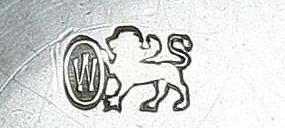
|
Photo 1 and 1a: This early, symmetrically
brightcut pattern was made by Whiting Manufacturing
Company (photo 1a) and
others. The brightcutting is shallow and sparse.
Since the piece is marked COIN (that is, 900/1000),
it can be dated to the 1860s.
|
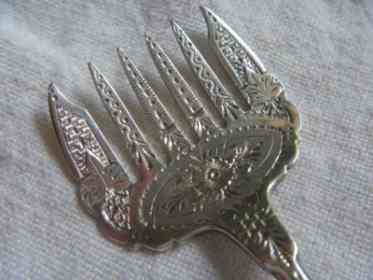
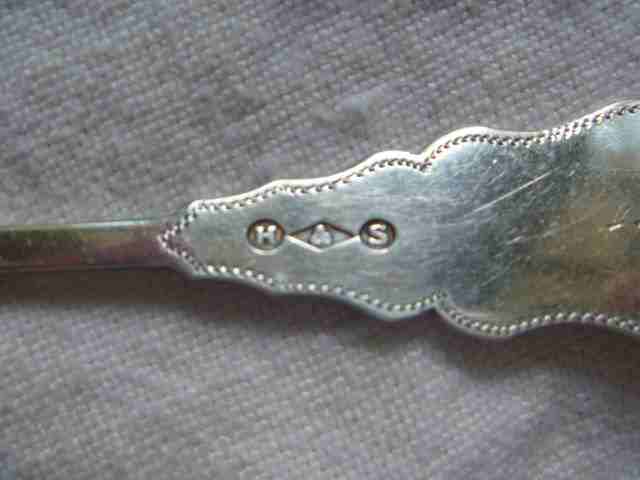
|
Photo 2 and 2a: This small fork is by a minor
company called Hotchkiss and Schreuder (see Photo 2a
for the mark).
Its symmetrical design indicates that it's probably
also from the 1860s, as does its coin metal
standard. Like very
many pieces of coin silver in the US, this one is
not so marked, but collectors learn to recognize the
flatware anyway
from company markings, patterns, engraving, and
other
clues.
|
BRIGHTCUT PATTERNS VS. ONE-OFF PIECES
Silver flatware was brightcut either in patterns for
regular, matching table services or in much lower multiples
-sometimes piece by piece. One U.S. company, Gorham
Manufacturing Co., produced about 20 brightcut sterling patterns
between 1872 and 1894 (the brightcutting appearing on the
handle). These patterns could be bought in whole services. The
year 1885 may have been the high point of matching brightcut
patterns, judging from their dates of issue.
The matching patterns tended to be delicate asymmetrical
designs, somewhat Japanese-inspired. Most were made after 1870
and so are sterling. The patterns mainly featured naturalistic
depictions of ivy, flowers, or whatever plants bent or drooped
in a picturesque way. The pattern in photo 3 was an extremely
popular design called "Lily" or "Lily Engraved, " which several
firms made. The brightcut patterns were cut onto sterling blanks
in the rounded Antique shape, as photo 3 shows. It is likely
that the big companies had permanent staffs of engravers who
could turn out the repeat patterns fairly rapidly.
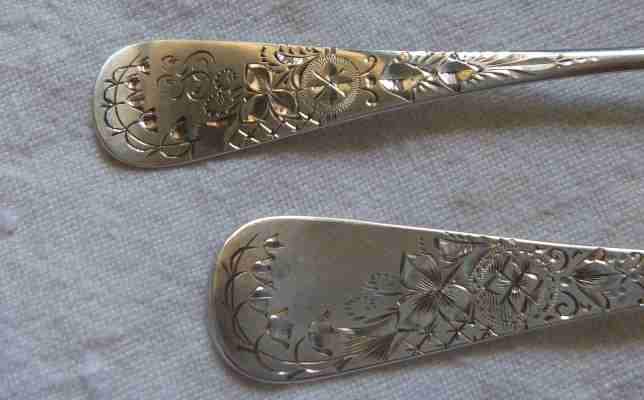
|
Photo 3: This pattern, called Antique Lily
Engraved or just plain Lily, was made by a handful
of companies
and was available in matching sets. The naturalistic,
asymmetrical brightcutting reflects the Aesthetic
Movement and Japanese design principles. These
pieces are sterling and from the
mid-1880s.
|
Brightcutting also appears on die-struck flatware patterns
from the late 19th century, in the open spaces provided by
blades and bowls. Here the term "pattern" becomes confusing. As
described in the previous paragraph, the place-setting flatware
with brightcut handles in matched sets constituted patterns, in
the sense that a bride might select "her" pattern. But regular
die-struck patterns put out by US manufacturers carried
brightcutting too. It served as extra embellishment and is found
mainly on the bowls or blades of serving pieces, rather than on
the handles.
Many of these brightcut serving pieces in die-struck patterns
were probably intended for gifts. Often they came with fitted
boxes. It is common to find dates engraved on the pieces to
commemorate a particular occasion. The pieces of flatware that
made good subjects for brightcutting had sizable open, plain
areas.
Flat pieces that often saw brightcut embellishment were pie
servers, master butter knives, fish sets (both pieces), crumbers,
and serrated cake saws, among others. Curved pieces that
accommodated brightcutting included salad sets, sugar spoons,
jelly servers, ladles, and serving spoons (most especially berry
spoons, which were a favorite). The piece in photo 4 is a berry
spoon in the pattern Laureate by Whiting. Besides the Whiting
symbol, it is marked "sterling" and "patent applied for. " It
measures 9 in. (23 cm) long to the tip and the shallow bowl is
3-1/3 in. (9 cm) long and 2 in. (5.5 cm) wide. These
measurements gave the engraver plenty of room for the
asymmetrical design. Reference books date the pattern Laureate
to 1890.
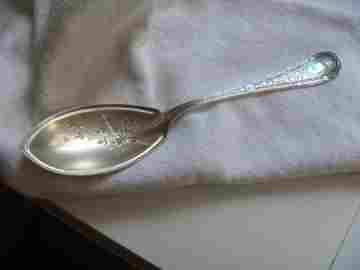
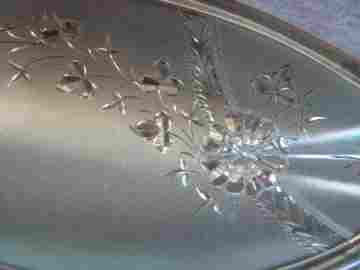
|
Photo 4 and 4a: This rather fancy berry spoon
was probably individually brightcut as a
presentation piece.
Its handle is in the Whiting die-struck pattern
named Laureate, marked sterling. Its date is the
latest of the pieces
presented here, 1890. The heyday of American
Victorian brightcutting was passing.
|
In a future article, I will detail some of the most
magnificent pieces of American Victorian brightcut, which
constitute a category unto themselves.
|

